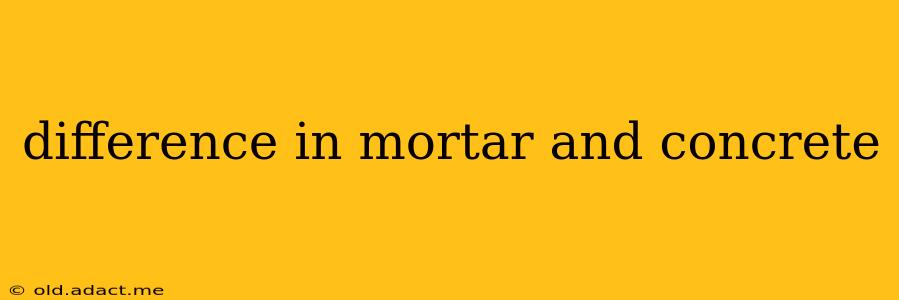Mortar and concrete are both construction materials made from a mixture of cement, aggregates, and water. However, their compositions, applications, and properties differ significantly. Understanding these differences is crucial for any construction project, whether you're a seasoned professional or a DIY enthusiast. This guide will delve into the key distinctions, addressing common questions along the way.
What is Mortar?
Mortar is primarily used as a bonding agent in masonry construction. It's a mixture of cement (or sometimes lime), fine aggregate (typically sand), and water. The key feature is its plasticity and workability, allowing it to be easily spread and molded to fill the gaps between bricks, blocks, or stones. Think of it as the "glue" that holds masonry units together. Its primary function isn't structural support in the same way concrete is, but rather to provide a strong bond and weather resistance.
What is Concrete?
Concrete, on the other hand, is a composite material used as a structural element. It consists of cement, coarse aggregates (like gravel or crushed stone), fine aggregates (sand), and water. The addition of coarse aggregate gives concrete its compressive strength and makes it suitable for creating structural elements like foundations, slabs, beams, and walls. Unlike mortar, concrete can bear significant weight and withstand considerable stress.
What are the Key Differences Between Mortar and Concrete?
Here's a table summarizing the key differences:
| Feature | Mortar | Concrete |
|---|---|---|
| Primary Use | Bonding masonry units | Structural element |
| Aggregate Type | Fine aggregate (sand) | Fine and coarse aggregates (sand, gravel) |
| Strength | Relatively low compressive strength | High compressive strength |
| Workability | High, easily spread and molded | Lower, requires more specialized tools |
| Applications | Bricklaying, blocklaying, stonework | Foundations, slabs, walls, beams |
| Water-Cement Ratio | Typically higher than concrete | Typically lower than mortar |
What is the Difference in the Ingredients of Mortar and Concrete?
The main difference lies in the aggregate. Mortar uses only fine aggregate (sand), which gives it its smooth, workable consistency. Concrete, however, incorporates both fine and coarse aggregates, significantly increasing its strength and density. The coarse aggregate provides the bulk and strength, while the fine aggregate fills the gaps and improves workability.
How Much Stronger is Concrete Compared to Mortar?
Concrete is significantly stronger than mortar in terms of compressive strength. While the exact strength varies depending on the mix design, concrete's compressive strength is typically many times greater than that of mortar. This difference in strength dictates their respective applications. Mortar is not designed to bear significant weight, whereas concrete is.
What are Some Common Uses for Mortar and Concrete?
Mortar:
- Bricklaying and blocklaying in walls, chimneys, and fireplaces
- Stonework in retaining walls, patios, and decorative features
- Pointing (refilling gaps in existing masonry)
Concrete:
- Foundations for buildings and structures
- Slabs for floors, driveways, and patios
- Walls and beams in buildings
- Bridge decks and pavements
- Retaining walls
Conclusion:
While both mortar and concrete use cement, aggregates, and water, their different compositions and properties lead to vastly different applications. Mortar serves as a bonding agent for masonry, while concrete provides the structural strength for numerous construction elements. Understanding these differences is essential for anyone involved in construction projects, ensuring the right material is selected for the job.
